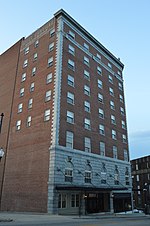Danville National Cemetery (Virginia)
Cemeteries on the National Register of Historic Places in VirginiaDanville, VirginiaHistoric American Landscapes Survey in VirginiaNational Register of Historic Places in Danville, VirginiaSouthern Virginia Registered Historic Place stubs ... and 3 more
Tourist attractions in Danville, VirginiaUnited States national cemeteriesVirginia in the American Civil War

Danville National Cemetery is a United States National Cemetery located in the city of Danville, Virginia. Administered by the United States Department of Veterans Affairs, it encompasses 3.5 acres (1.4 ha) and, as of the end of 2005, it had 2,282 interments. It is managed by Salisbury National Cemetery.
Excerpt from the Wikipedia article Danville National Cemetery (Virginia) (License: CC BY-SA 3.0, Authors, Images).Danville National Cemetery (Virginia)
Lee Street, Danville
Geographical coordinates (GPS) Address Nearby Places Show on map
Geographical coordinates (GPS)
| Latitude | Longitude |
|---|---|
| N 36.576944444444 ° | E -79.389444444444 ° |
Address
Lee Street
24541 Danville
Virginia, United States
Open on Google Maps









